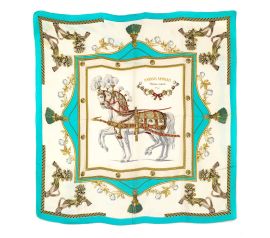HERMES CARRE FOULARD "HARNAIS FRANCAIS PREMIERE EMPIRE"
in seta, stampa "Harnais Français Premier Empire" disegnata dall'artista Hugo Grygkar nel 1957, raffigura al centro una coppia di cavalli al trotto, firmato "Hermès. Paris", dim. cm 90x90
HERMES "HARNAIS FRANCAIS PREMIERE EMPIRE" SCARF
La coppia di cavalli in tenuta da grande apparato che si muove in perfetta sincronia riproduce un particolare del progetto della carrozza per l'incoronazione di Napoleone elaborato degli architetti Pierre- François-Léonard Fontaine e Charles Percier nel 1804. Tale progetto non fu mai realizzato e il disegno acquarellato è oggi conservato nel museo privato di Hermès.
La prima versione prevedeva un attelage da otto cavalli ma l'imperatore ritenne, prudentemente, che un apparato troppo lussuoso non sarebbe stato gradito dal popolo che aveva ancora ben presenti i fasti prerivoluzionari e la successiva distruzione di tutti gli equipaggi dei re di Francia.
Anche se non realizzarono la carrozza per il "Sacre", Fontaine e Percier ebbero comunque molta parte dei progetti di elaborazione del gusto durante l'Impero. Fontaine in architettura, con la realizzazione dei progetti di ristrutturazione di Malmaison, Versailles, Fountainebleau, e moltissimi altri edifici dopo la sua nomina, nel 1801, ad architetto governativo.
Percier soprattutto come artefice del nuovo gusto formale che improntò un'epoca, nella decorazione d'interni e nei progetti degli arredi, introducendo motivi cari a Napoleone ispirati alla classicità e all'antico Egitto.
Un particolare interessante: negli angoli di questo carré le coppie di cavalli stilizzati sono stati ripresi da un cofanetto in legno dipinto che fa parte del tesoro di Tutankhamon, oggi conservato al Museo Egizio del Cairo, che rappresenta il faraone alla guida del suo carro mentre combatte contro i nubiani.
The pair of horses in a large apparatus that moves in perfect synchrony reproduces a detail of the project of the carriage for the coronation of Napoleon elaborated by the architects Pierre-François-Léonard Fontaine and Charles Percier in 1804. This project was never realized and the watercolor drawing is now preserved in the private museum of Hermès.
The first version involved an eight-horse attelage but the emperor prudently believed that apparently too luxurious it would not have been appreciated by the people who still had in mind the pre-revolutionary splendor and the subsequent destruction of all the equipment of France.
Although they did not make the carriage for the "Sacre", Fontaine and Percier still had much of the taste development projects during the empire. Fontaine in architecture, with the implementation of the renovation projects of Malmaison, Versailles, Fountainebleau, and many other buildings after his appointment, in 1801, as government architect.
Percier above all as the architect of the new formal taste that marked an era, in interior decoration and in the projects of furnishings, introducing motifs dear to Napoleon inspired by classicism and ancient Egypt.
An interesting detail: in the corners of this carré the stylized pairs of horses were taken from a painted wooden box that is part of the Tutankhamun treasure, now preserved in the Egyptian Museum in Cairo, which describes the pharaoh driving his chariot while he fights against the Nubians.
Bibliografia:
"Mito e Bellezza", Catalogo a cura di Roberta Martinelli e Velia Gini Bartoli, pp 90-94, Mondadori Electa S.p.A., Verona, 2009.




